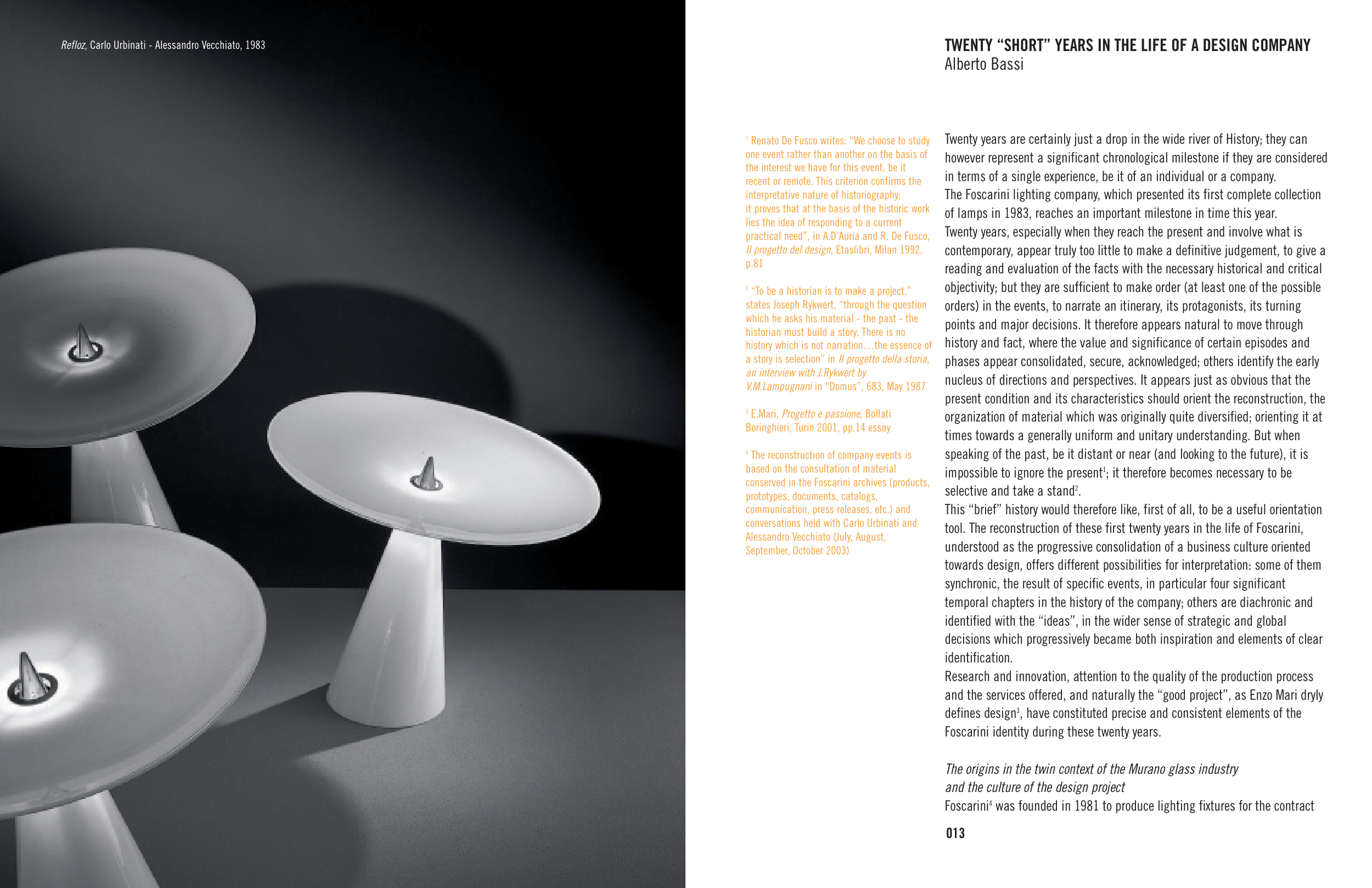TWENTY “SHORT” YEARS IN THE LIFE OF A DESIGN COMPANY
Alberto Bassi
Twenty years are certainly just a drop in the wide river of History; they can
however represent a significant chronological milestone if they are considered
in terms of a single experience, be it of an individual or a company.
The Foscarini lighting company, which presented its first complete collection
of lamps in 1983, reaches an important milestone in time this year.
Twenty years, especially when they reach the present and involve what is
contemporary, appear truly too little to make a definitive judgement, to give a
reading and evaluation of the facts with the necessary historical and critical
objectivity; but they are sufficient to make order (at least one of the possible
orders) in the events, to narrate an itinerary, its protagonists, its turning
points and major decisions. It therefore appears natural to move through
history and fact, where the value and significance of certain episodes and
phases appear consolidated, secure, acknowledged; others identify the early
nucleus of directions and perspectives. It appears just as obvious that the
present condition and its characteristics should orient the reconstruction, the
organization of material which was originally quite diversified; orienting it at
times towards a generally uniform and unitary understanding. But when
speaking of the past, be it distant or near (and looking to the future), it is
impossible to ignore the present1; it therefore becomes necessary to be
selective and take a stand2.
This “brief” history would therefore like, first of all, to be a useful orientation
tool. The reconstruction of these first twenty years in the life of Foscarini,
understood as the progressive consolidation of a business culture oriented
towards design, offers different possibilities for interpretation: some of them
synchronic, the result of specific events, in particular four significant
temporal chapters in the history of the company; others are diachronic and
identified with the “ideas”, in the wider sense of strategic and global
decisions which progressively became both inspiration and elements of clear
identification.
Research and innovation, attention to the quality of the production process
and the services offered, and naturally the “good project”, as Enzo Mari dryly
defines design3, have constituted precise and consistent elements of the
Foscarini identity during these twenty years.
The origins in the twin context of the Murano glass industry
and the culture of the design project
Foscarini4 was founded in 1981 to produce lighting fixtures for the contract
1 Renato De Fusco writes: “We choose to study
one event rather than another on the basis of
the interest we have for this event, be it
recent or remote. This criterion confirms the
interpretative nature of historiography;
it proves that at the basis of the historic work
lies the idea of responding to a current
practical need”, in A.D’Auria and R. De Fusco,
Il progetto del design, Etaslibri, Milan 1992,
p.81
2 “To be a historian is to make a project,”
states Joseph Rykwert, “through the question
which he asks his material - the past - the
historian must build a story. There is no
history which is not narration…the essence of
a story is selection” in Il progetto della storia,
an interview with J.Rykwert by
V.M.Lampugnani in “Domus”, 683, May 1987
3 E.Mari, Progetto e passione, Bollati
Boringhieri, Turin 2001, pp.14 essay
4 The reconstruction of company events is
based on the consultation of material
conserved in the Foscarini archives (products,
prototypes, documents, catalogs,
communication, press releases, etc.) and
conversations held with Carlo Urbinati and
Alessandro Vecchiato (July, August,
September, October 2003)
013
Refloz, Carlo Urbinati - Alessandro Vecchiato, 1983


